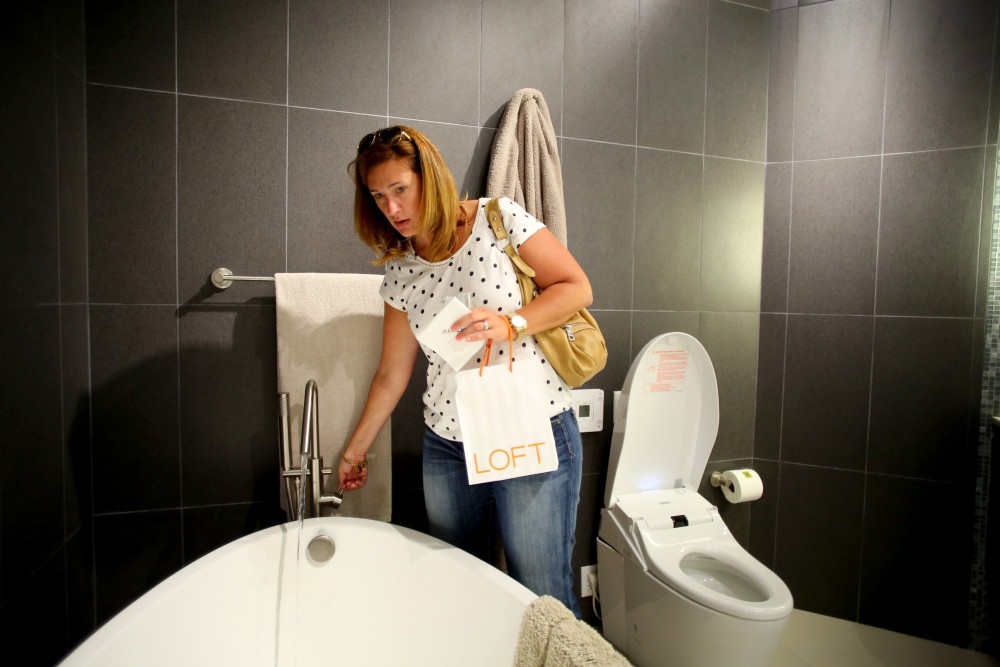By Alexia Elejalde-Ruiz
Chicago Tribune.
There are appliance stores, and then there is Pirch.
At its new showroom in Oakbrook Center, on Chicago’s North Shore, you can sidle up to a cafe for a free cappuccino, enjoy the smells and samples that chefs cook up in working kitchens, or reserve a time to take a shower, yes, take a shower, in the Sanctuary, a eucalyptus-scented room with steam showers and a granite bathtub filled by a spigot that pours dramatically from the ceiling.
Offering such heightened store experiences is becoming increasingly paramount for retailers seeking to give shoppers a reason to get off the couch, off the Internet and into their stores for something beyond the lowest price, industry analysts say.
“These are the kinds of places that are developing more as a counterpoint to a digital experience and saying, ‘Come in and touch and feel; it’s worth the trip,'” said Wendy Liebmann, CEO of New York-based WSL Strategic Retail.
More than stores that simply let you interact with the product, Liebmann said, “these beautiful inspirational settings … create almost a mouth-watering quality.”
While some retailers, like Apple or Anthropologie, have been offering such high-touch retail experiences for years, more companies are joining in as retail success stories become polarized between the very efficient, commodity-driven businesses (think dollar stores) and the inspirational, experiential stores, said Neil Stern, a senior partner at Chicago-based retail consulting practice McMillan Doolittle.
“I think the difference between now and five years ago is that (back then) you still could get by by playing the middle, and it’s getting harder and harder to do that,” Stern said.
Take Urban Outfitters’ new 57,000-square-foot New York City flagship, which features an Intelligentsia coffee shop, a hair salon, and an Instagram photo printing booth.
Under Armour isn’t opening stores but rather “brand houses,” including its largest yet on Michigan Avenue. in Chicago come next spring, that are interactive spaces with digital displays.
Restoration Hardware is investing massively to convert landmark buildings into spectacular “full-line design galleries,” including the 58,000-square-foot historic Three Arts Club of Chicago, where RH plans to open in spring of 2015.
The high-end furnishings retailer so far has opened six full-line design galleries in the U.S. and plans to transform all of its stores into the large, immersive concepts, a strategy that “defies conventional wisdom that everything is moving to the Web and retail stores are a dying platform,” RH CEO Gary Friedman told analysts during an earnings conference call last month.
The “unique and dominant locations …
buy zoloft online https://blackmenheal.org/wp-content/languages/new/noprescription/zoloft-no-prescription.html no prescription
will enable us to unlock the value of our current and future product assortments,” he said.
He expects revenues to rise to $4 billion to $5 billion, triple what they were last year, once the real estate transformation is complete.
RH declined to provide further details about the Chicago store, but a proposal submitted with the city’s Landmarks Commission sought permission to build a new glass skylight over the courtyard and a 1-story rooftop addition.
The most recently opened gallery, at the historic post office in Greenwich, Conn., has an operating tea atelier and outdoor gardens.
At a more mass-market level, Walgreens has gone high-class with whiskey tastings and soft-serve yogurt at a few beautiful flagship locations in Chicago, such as the Wrigley Building, and a restored bank building in Wicker Park, where no trip is complete without visiting the Vitamin Vault.
Even a 7-Eleven, on North McClurg Court, has spiffed up with cafe seating, fresh produce, upscale wines and elegant signage.
To Jeffery Sears, chief executive of San Diego-based Pirch, the new retail path mirrors what it was when he was a kid 50 years ago and the top department stores offered top-line care.
“What’s returning to great retail is truly the concept of activation and learning and engaging a customer in a way other than just the transaction,” Sears said.
With amenities like the Bliss Cafe, staffed by “baristas of joy” at the entrance, seven “dream rooms” where guests can meet with designers to plan their homes on digital screens and free daily cooking classes in its sleek open kitchens, Pirch “creates a bond and a place to gather and to learn, and I think that’s what human beings do,” Sears said.
Many of the gatherers don’t buy anything, Sears said, but that’s all right, as the point is to inspire and form relationships that last.
Pirch works mostly with builders and designers but also sells directly to consumers or connects them with professionals to help them with home projects.














































































































































































































































































































































































